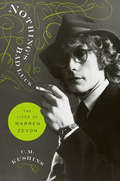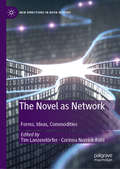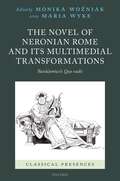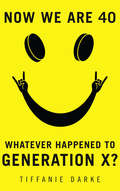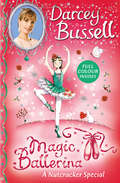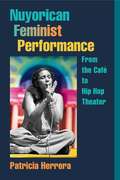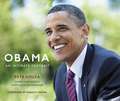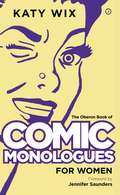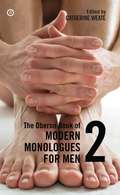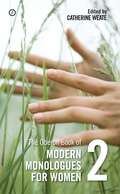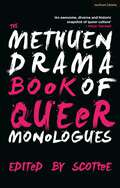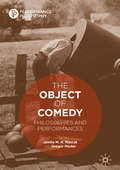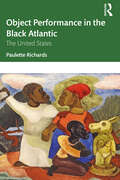- Table View
- List View
Nothing's Bad Luck: The Lives of Warren Zevon
by C. M. KushinsBiography of legendary singer-songwriter Warren Zevon, spanning his nomadic youth and early recording career to his substance abuse, final album, and posthumous Grammy AwardsAs is the case with so many musicians, the life of Warren Zevon was blessed with talent and opportunity yet also beset by tragedy and setbacks. Raised mostly by his mother with an occasional cameo from his gangster father, Warren had an affinity and talent for music at an early age. Taking to the piano and guitar almost instantly, he began imitating and soon creating songs at every opportunity. After an impromptu performance in the right place at the right time, a record deal landed on the lap of a teenager who was eager to set out on his own and make a name for himself. But of course, where fame is concerned, things are never quite so simple.Drawing on original interviews with those closest to Zevon, including Crystal Zevon, Jackson Browne, Mitch Albom, Danny Goldberg, Barney Hoskyns, and Merle Ginsberg, Nothing's Bad Luck tells the story of one of rock's greatest talents. Journalist C.M. Kushins not only examines Zevon's troubled personal life and sophisticated, ever-changing musical style, but emphasizes the moments in which the two are inseparable, and ultimately paints Zevon as a hot-headed, literary, compelling, musical genius worthy of the same tier as that of Bob Dylan and Neil Young.In Nothing's Bad Luck, Kushins at last gives Warren Zevon the serious, in-depth biographical treatment he deserves, making the life of this complex subject accessible to fans old and new for the very first time.
The Novel after Film: Modernism and the Decline of Autonomy
by Jonathan FoltzAccording to prevailing media histories, film long ago ought to have rendered the novel obsolete. The irony of this story is that the "death of the novel" at the hands of film has for a long time now been a pervasive trope of the novel's continued reinvention. The Novel After Film offers a substantial reassessment of this paradoxical new condition of novelistic practice in which writers have re-imagined the novel in the shadow of film. In the cinema, a generation of modernist writers found a medium whose bad form was also laced with the glamor of the popular, and whose unfamiliar visual language seemed to harbor a future for innovative writing after modernism. How did the cinema-with its crude continuities, crowded theaters, stock plots, and ghostly images-seem to flout conventional ideas of narrative form? What new literacies of experience and representation did film seem to promise? As The Novel After Film demonstrates, this fascination with film was played out against the backdrop of a growing discourse about the novel's respectability. As the modern novel was increasingly venerated as a genre of aesthetic refinement, authors such as Virginia Woolf, H. D., Henry Green and Aldous Huxley turned their attention to the cinema in search of alternative aesthetic histories. For authors working in modernism's atmosphere of heightened formal sophistication, film's bad form took on a perverse attraction. In this way, film played a key role in helping writers negotiate a transforming public culture which seemed to be leaving the novel behind.
The Novel after Film: Modernism and the Decline of Autonomy
by Jonathan FoltzAccording to prevailing media histories, film long ago ought to have rendered the novel obsolete. The irony of this story is that the "death of the novel" at the hands of film has for a long time now been a pervasive trope of the novel's continued reinvention. The Novel After Film offers a substantial reassessment of this paradoxical new condition of novelistic practice in which writers have re-imagined the novel in the shadow of film. In the cinema, a generation of modernist writers found a medium whose bad form was also laced with the glamor of the popular, and whose unfamiliar visual language seemed to harbor a future for innovative writing after modernism. How did the cinema-with its crude continuities, crowded theaters, stock plots, and ghostly images-seem to flout conventional ideas of narrative form? What new literacies of experience and representation did film seem to promise? As The Novel After Film demonstrates, this fascination with film was played out against the backdrop of a growing discourse about the novel's respectability. As the modern novel was increasingly venerated as a genre of aesthetic refinement, authors such as Virginia Woolf, H. D., Henry Green and Aldous Huxley turned their attention to the cinema in search of alternative aesthetic histories. For authors working in modernism's atmosphere of heightened formal sophistication, film's bad form took on a perverse attraction. In this way, film played a key role in helping writers negotiate a transforming public culture which seemed to be leaving the novel behind.
Novel Approaches to Lesbian History (Palgrave Studies in Contemporary Women’s Writing)
by Linda GarberNovel Approaches to Lesbian History tells a tale about history and community in our allegedly post-identity era, examining contemporary novels that depict lesbian characters in recognizable historical situations. These imaginative stories provide a politically vital, speculative past in the face of a sketchy, problematic archive. Among the memorable characters in some 200 novels are pirates, cowgirls, and famous artists, ghosts and time travellers, immigrants and lovers. The best lesbian historical novels are conscientious and buoyant as they engage critical historiographical questions, but Novel Approaches also discusses the class and race biases that weigh on the genre. Some lesbian historical novels are based on archival evidence, others on conjecture or fantasy, but all convey the true fact that identity is elusive without a past, without which its future is nearly impossible.
The Novel as Network: Forms, Ideas, Commodities (New Directions in Book History)
by Tim Lanzendörfer Corinna Norrick-RühlThe Novel as Network: Forms, Ideas, Commodities engages with the contemporary Anglophone novel and its derivatives and by-products such as graphic novels, comics, podcasts, and Quality TV. This collection investigates the meaning of the novel in the larger system of contemporary media production and (post-)print culture, viewing the novel through the lens of actor network theory as a node in the novel network. Chapters underscore the deep interconnection between all the aspects of the novel, between the novel as a (literary) form, as an idea, and as a commodity. Bringing together experts from American, British, and Postcolonial Studies, as well as Book, Publishing, and Media Studies, this collection offers a new vantage point to view the novel in its multifaceted expressions today.
The Novel of Neronian Rome and its Multimedial Transformations: Sienkiewicz's Quo vadis (Classical Presences)
by Maria Wyke Monika WoźniakThe Polish writer Henryk Sienkiewicz was awarded the Nobel Prize for literature in 1905 largely on the basis of his historical novel Quo vadis: A Narrative of the Time of Nero. The novel's vivid and moving reconstruction of religious persecution and struggle against tyranny catapulted its author into literary stardom. But, before long, Quo vadis began to 'detach' itself from the person of its author and to become a multimedial, mass culture phenomenon. In the West and in the East, it was adapted for stage and screen, provided the inspiration for works of music and other genres of literature, was transformed into comic strips and illustrated children's books, was cited in advertising, and referenced in everyday objects of material culture. This volume explores the strategies Sienkiewicz used to recreate Neronian Rome and the reasons his novel was so avidly consumed and reproduced in new editions, translations, visual illustrations, and adaptations to the stage and screen across Europe and in the United States. The contributions render visible for English-speaking readers the impact of a Polish work of high literature on the presence of Nero, Christian persecution, and ancient Rome in Western popular culture.
The Novel of Neronian Rome and its Multimedial Transformations: Sienkiewicz's Quo vadis (Classical Presences)
The Polish writer Henryk Sienkiewicz was awarded the Nobel Prize for literature in 1905 largely on the basis of his historical novel Quo vadis: A Narrative of the Time of Nero. The novel's vivid and moving reconstruction of religious persecution and struggle against tyranny catapulted its author into literary stardom. But, before long, Quo vadis began to 'detach' itself from the person of its author and to become a multimedial, mass culture phenomenon. In the West and in the East, it was adapted for stage and screen, provided the inspiration for works of music and other genres of literature, was transformed into comic strips and illustrated children's books, was cited in advertising, and referenced in everyday objects of material culture. This volume explores the strategies Sienkiewicz used to recreate Neronian Rome and the reasons his novel was so avidly consumed and reproduced in new editions, translations, visual illustrations, and adaptations to the stage and screen across Europe and in the United States. The contributions render visible for English-speaking readers the impact of a Polish work of high literature on the presence of Nero, Christian persecution, and ancient Rome in Western popular culture.
Now F**k Off!: The Little Guide to Succession
by Orange Hippo!In January 2024, Succession won four Golden Globes - including Best Drama - from a record 13 nominations, cementing the truth in stone: no other show since The Sopranos has come close to its influence, impact and intelligence. Fuelled by the uncertainty of the global pandemic and the ugly political aftermath of the 2016 and 2020 U.S. elections, Succession's premise is simple but devastating: rip a despicable yet powerful family apart using jaw-droppingly innovative and original one-liners, led by a wealth of top TV talent.The Little Guide to Succession is an essential and hilarious read for fans of the Roy family and the rest of the business class ensemble's infamous and now-iconic wicked wit and quickfire quips. All the best quotes here, ready to be deployed at your command from this compact celebration of Succession."You can't make a Tomlette without breaking some Gregs."Tom, to Greg (emailed to Greg 67 times in one evening), season two, episode nine, "DC"."You're a clumsy interloper, no one trusts you and the only guy pulling for you is dead. Now you're just married to the ex-boss's daughter and she doesn't even like you. You are fairly, squarely fucked."Karl, to Tom, when he "respectfully" threw his hat into the ring for interim CEO, season four, episode four, "Honeymoon States"."You look like a dildo dipped in beard trimmings."Roman, to designer-stubbled Stewy, season two, episode two, "Vaulter".3,021The number of times the word "fuck" is said throughout the show's four seasons. That's an average of 76 "fucks" per episode, or one every 1.2 minutes.
Now Hear This: A Book About Sound
by John NaylorThis book explains the nature of sound both as a physical phenomenon and as a sensation, how it travels through air and water, and how the hearing system evolved to convert these vibrations into sensations. Drawing on physics, biology, neuroscience, philosophy, literature, history, anecdote, and personal experience, "Now Hear This" is a wide-ranging exploration of the nature of sound and hearing that opens up a fascinating world of sounds from the mundane to the unusual and seeks above all to persuade the reader of the wisdom of John Cage’s advice that “Wherever we are what we hear is mostly noise. When we ignore it, it disturbs us. When we listen to it, we find it fascinating.”
Now We Are 40
by Tiffanie DarkeWhat happened to Generation X? Millenials dominate our Facebook feeds and people bang on about the baby boomers – but what about us? The lost generation, the middle youth, the middle child of today. Are we still cool?
Now What?: On a Mission to Fix Broken Britain
by Carol VordermanPolitics: The three vowels and five consonants which control our world.'But what has politics got to do with me?' I hear you ask. Well, quite a lot really. Whether you like it or not, it affects every single thing in your life from the moment you wake up in the morning until you crawl into bed at night.But some of our political elite make it feel like a club which we have not been invited to join. The privileged few who want to keep it all for the privileged few. I hope this book can explain much, make you laugh out loud and make you realise that together our voices are powerful.Buckle up and come on a political rollercoaster with me - 'an old bird with an iPhone'. This is a book for people who don't normally think about politics. We have a new government and have bid a loud goodbye to the Tories, but the issues that allowed the last government to mismanage and deceive us for so long lie deep. Amidst a landscape of economic turmoil and deepening societal fractures, we need to see a new age of accountability in our political system.With her characteristic outspokenness and irrepressible sense of humour, in Now What? On a Mission to Fix Broken Britain, Carol Vorderman exposes the intricate web of influence responsible for our nation's unravelling and provides us with a toolkit for building a better and fairer Britain.Part diary, part manifesto, part journey down the rabbit hole of British politics, this is the story of how 'an old bird with an iPhone' exposed the incompetence and lies of the establishment, and inspired countless others to find their voice and stand up for what they believe in.
A Nutcracker Colour Special (Magic Ballerina)
by Darcey BussellBeautiful full colour illustrations bring this magical ballet adventure to life in a special ebook edition!
Nutrition for Dance and Performance
by Jasmine ChallisNutrition for Dance and Performance is the first complete textbook written by an experienced dietitian specialising in the field of dance nutrition. It seeks to provide both dancers-in-training and instructors with practical advice on dance nutrition for health and performance. It is also highly relevant for dance professionals. With an in-depth and extensive coverage on all nutrition topics relevant to dancers, this book covers nutrition for the scenarios dancers face, including day-to-day training and rehearsals, peak performance, injuries, immunonutrition, nutrition and stress management. Information is included on topics applicable to individual dancers including advice for dancers with Type 1 diabetes and clinical conditions relating to gut health. The book guides the reader through the macronutrients making up the diet, their chemical structure and their role in health and optimal performance. Readers are shown how to estimate energy and nutrient needs based on their schedule, type of dance undertaken and personal goals before considering the practical aspects of dance nutrition; from nutrition planning to dietary supplements, strategies for assessing the need to alter body composition and guidance on undertaking health-focused changes. Nutrition for Dance and Performance combines and condenses the author’s knowledge and many years of experience working in the dance industry to translate nutrition science into a practical guide. Bringing together the latest research in dance science and nutrition, this book aims to be a trusted reference and practical textbook for students of Dance, Dance Nutrition, Dance Performance, Sport Nutrition and Sport Science more generally as well as for those training in the dance industry, dance teachers and professionals. Jasmine Challis is a freelance Registered Nutritionist (UK Association for Nutrition) and Dietitian registered with the Health Care Professions Council, and is on the UK Sport and Exercise Nutrition Register (SENR) focusing on dance. She completed an MRes in Sport and Exercise Science in 2018. She is on the Dance Medicine and Science Expert Panel for One Dance UK and is on the board of The Bridge Dance Project. She has worked across the dance field for over 30 years giving talks, running workshops and providing 1:1 sessions for dancers and dance students.
Nutrition for Dance and Performance
by Jasmine ChallisNutrition for Dance and Performance is the first complete textbook written by an experienced dietitian specialising in the field of dance nutrition. It seeks to provide both dancers-in-training and instructors with practical advice on dance nutrition for health and performance. It is also highly relevant for dance professionals. With an in-depth and extensive coverage on all nutrition topics relevant to dancers, this book covers nutrition for the scenarios dancers face, including day-to-day training and rehearsals, peak performance, injuries, immunonutrition, nutrition and stress management. Information is included on topics applicable to individual dancers including advice for dancers with Type 1 diabetes and clinical conditions relating to gut health. The book guides the reader through the macronutrients making up the diet, their chemical structure and their role in health and optimal performance. Readers are shown how to estimate energy and nutrient needs based on their schedule, type of dance undertaken and personal goals before considering the practical aspects of dance nutrition; from nutrition planning to dietary supplements, strategies for assessing the need to alter body composition and guidance on undertaking health-focused changes. Nutrition for Dance and Performance combines and condenses the author’s knowledge and many years of experience working in the dance industry to translate nutrition science into a practical guide. Bringing together the latest research in dance science and nutrition, this book aims to be a trusted reference and practical textbook for students of Dance, Dance Nutrition, Dance Performance, Sport Nutrition and Sport Science more generally as well as for those training in the dance industry, dance teachers and professionals. Jasmine Challis is a freelance Registered Nutritionist (UK Association for Nutrition) and Dietitian registered with the Health Care Professions Council, and is on the UK Sport and Exercise Nutrition Register (SENR) focusing on dance. She completed an MRes in Sport and Exercise Science in 2018. She is on the Dance Medicine and Science Expert Panel for One Dance UK and is on the board of The Bridge Dance Project. She has worked across the dance field for over 30 years giving talks, running workshops and providing 1:1 sessions for dancers and dance students.
Nuts and Bolts Filmmaking: Practical Techniques for the Guerilla Filmmaker
by Dan RahmelNuts and Bolts Filmmaking, an ideal book for the rapidly growing number of low-budget filmmakers, provides how-to information on the day-to-day techniques of actual low-budget production. Containing construction details describing how to replicate expensive tools for under $30 a piece, this book provides quick and inexpensive remedies to both the most common and most difficult production challenges. Nuts and Bolts Filmmaking is an invaluable resource to anyone looking to make a film without a big budget.
Nuts and Bolts Filmmaking: Practical Techniques for the Guerilla Filmmaker
by Dan RahmelNuts and Bolts Filmmaking, an ideal book for the rapidly growing number of low-budget filmmakers, provides how-to information on the day-to-day techniques of actual low-budget production. Containing construction details describing how to replicate expensive tools for under $30 a piece, this book provides quick and inexpensive remedies to both the most common and most difficult production challenges. Nuts and Bolts Filmmaking is an invaluable resource to anyone looking to make a film without a big budget.
Nuyorican Feminist Performance: From the Café to Hip Hop Theater
by Patricia HerreraThe Nuyorican Poets Café has for the past forty years provided a space for multicultural artistic expression and a platform for the articulation of Puerto Rican and black cultural politics. The Café’s performances—poetry, music, hip hop, comedy, and drama—have been studied in detail, but until now, little attention has been paid to the voices of its women artists. Through archival research and interview, Nuyorican Feminist Performance examines the contributions of 1970s and ’80s performeras and how they challenged the Café’s gender politics. It also looks at recent artists who have built on that foundation with hip hop performances that speak to contemporary audiences. The book spotlights the work of foundational artists such as Sandra María Esteves, Martita Morales, Luz Rodríguez, and Amina Muñoz, before turning to contemporary artists La Bruja, Mariposa, Aya de León, and Nilaja Sun, who infuse their poetry and solo pieces with both Nuyorican and hip hop aesthetics.
Obama: The Historic Presidency in Photographs
by Pete SouzaThe definitive visual biography of Barack Obama's historic presidency, captured in unprecedented detail by his Chief White House photographer, presented in an oversize, 12"x10"exquisitely produced format, and featuring a foreword from the President himself.Pete Souza was with President Obama during more crucial moments than anyone else and he photographed them all - from the highly classified to the disarmingly candid. Obama: An Intimate Portrait reproduces more than three hundred of Souza's most iconic photographs in exquisite detail, some of which have never been published before. Souza's photographs, with the behind-the-scenes captions and stories that accompany them, document the most consequential hours of the Presidency alongside unguarded moments with the President's family, his encounters with children, interactions with world leaders and cultural figures, and more. These images communicate the pace and power of America's highest office and reveal the spirit of the extraordinary man who became President. The result is a portrait of exceptional intimacy and a stunning record of a landmark era in American history.'Precious historical documents . . . vividly human and often funny . . . these images tell the true story of a presidency that words have failed' Jonathan Jones, Guardian
The Oberon Book of Comic Monologues for Women: Volume One
by Katy Wix Jennifer Saunders'So Katy Wix has written this book of comic monologues and I may have to steal some of them. Although written for the female voice, I dare say they would stand up very well if you were a gentleman and changed the odd word or two. Here you have a book filled with brilliant characters and much funny. Each piece is bubbling with the quirky genius that makes Miss Wix one of the funniest performers / writers around. If I was ever called to audition, which I am not often despite being largely available and willing to try my hand at most things, I would be most grateful to Miss Wix for this fantastic collection. However most likely I shall keep it by my bed to dip into for laughs. It is a very good read. Well done Miss Wix.' Jennifer Saunders There are many monologues books on the market but very few provide rich material for comedy. This collection from up and coming comedian & actress Katy Wix plugs that gap and provides female performers with the kind of wonderfully warm and interesting characters that they need – and deserve. A comedian and writer, Wix has for the past few years been writing audition speeches for students at drama schools including RADA, LAMDA, Drama Centre and The Royal Welsh College of Music and Drama. A book of contemporary comedy monologues does not exist for today's actor or indeed a book comprising solely of showcase speeches. This is a collection of very funny and original audition speeches filling a significant gap in the market: made up of monologues for various age ranges, each with a running time of two to three minutes. The brevity in length makes these ideal for auditions or showcases and the variety in age and style encompasses different comedic approaches; from the very quirky to the more traditional – perfect for every type of performer.
The Oberon Book of Modern Monologues for Men: Volume Two
by Catherine WeateMonologues are an essential part of every actor’s toolkit. Actors are required to perform monologues regularly throughout their career: preparing for drama school entry, showcasing skills for agents or auditioning for a role. Following on from the bestselling first volume (2008), this book showcases selected monologues from some of the finest modern plays by some of today’s leading contemporary playwrights. These monologues contain a diverse range of quirky and memorable characters that cross cultural and historical boundaries. The pieces are helpfully organised into age-specific groups: ‘Teens’, ‘Twenties’, ‘Thirties’ and ‘Forties plus’.
The Oberon Book of Modern Monologues for Women: Volume Two
by Catherine WeateMonologues are an essential part of every actor’s toolkit. Actors are required to perform monologues regularly throughout their career: preparing for drama school entry, showcasing skills for agents or auditioning for a role. Following on from the bestselling first volume (2008), this book showcases selected monologues from some of the finest modern plays by some of today’s leading contemporary playwrights. These monologues contain a diverse range of quirky and memorable characters that cross cultural and historical boundaries. The pieces are helpfully organised into age-specific groups: ‘Teens’, ‘Twenties’, ‘Thirties’ and ‘Forties plus’.
The Oberon Book of Queer Monologues
by ScotteeThe first collection of its kind, The Oberon Book of Queer Monologues chronicles over one hundred years of queer and trans performance.Combining classical and contemporary stage plays with spoken word and performance art, this anthology features over forty extracts from some of the most exciting stage works in the English-speaking world. It will be an essential tool for artists seeking monologues for auditions or training; a comprehensive guide through the hidden histories of queer theatre; and a celebration of the LGBTQIA+ community.Curated by award-winning artist Scottee.
The Oberon Glossary of Theatrical Terms: Theatre Jargon Explained
by Colin WinslowAnyone who has ever had to call a plumber, let alone try to fathom a computer handbook, will be fatally familiar with the bewilderment of the outsider exposed to the shop-talk of professions other than his or her own. Do you know your Mirror Scrims from your Mirror Balls? Or your Get Outs from your Get Ins? Or indeed your Get Offs? If not, The Oberon Glossary of Theatrical Terms 2nd edition is here to help you out. The Oberon Glossary of Theatrical Terms 2nd edition is a new edition of the successful A-Z which includes explanations of over 1,300 technical, backstage, acting, musical, dance and show business terms in common usage. Completely revised and updated, this concise and compact glossary explains and clarifies all theatre jargon. From amateur dramatics fans to West End directors, this new book is a must have addition to the bookshelves of all theatre and performing arts aficionados.
The Object of Comedy: Philosophies and Performances (Performance Philosophy)
by Jamila M. H. Mascat Gregor ModerWhat is the object of comedy? What makes us laugh and why? Is comedy subversive, restorative or reparative? What is at stake politically, socially and metaphysically when it comes to comedic performances? This book investigates not only the object of comedy but also its objectives – both its deliberate goals and its unintended side effects.In researching the object of comedy, the contributions gathered here encounter comedy as a philosophical object: instead of approaching comedy as a genre, the book engages with it as a language, a medium, an artifice, a weapon, a puzzle or a trouble, a vocation and a repetition. Thus philosophy meets comedy at the intersection of various fields (e.g. psychoanalysis, film studies, cultural studies, and performance studies) –regions that comical practices and theories in fact already traverse.
Object Performance in the Black Atlantic: The United States
by Paulette RichardsGiven that slaveholders prohibited the creation of African-style performing objects, is there a traceable connection between traditional African puppets, masks, and performing objects and contemporary African American puppetry? This study approaches the question by looking at the whole performance complex surrounding African performing objects and examines the material culture of object performance. Object Performance in the Black Atlantic argues that since human beings can attribute private, personal meanings to objects obtained for personal use such as dolls, vessels, and quilts, the lines of material culture continuity between African and African American object performance run through objects that performed in ritual rather than theatrical capacity. Split into three parts, this book starts by outlining the spaces where the African American object performance complex persisted through the period of slavery. Part Two traces how African Americans began to reclaim object performance in the era of Jim Crow segregation and Part Three details how increased educational and economic opportunities along with new media technologies enabled African Americans to use performing objects as a powerful mode of resistance to the objectification of Black bodies. This is an essential study for any students of puppetry and material performance, and particularly those concerned with African American performance and performance in North America more broadly.
